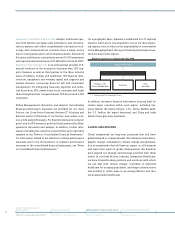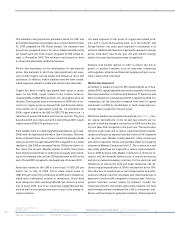Siemens 2009 Annual Report Download - page 141
Download and view the complete annual report
Please find page 141 of the 2009 Siemens annual report below. You can navigate through the pages in the report by either clicking on the pages listed below, or by using the keyword search tool below to find specific information within the annual report.
53
Managing Board statements, Independent auditors’ report, Additional information
95 Net assets position 97 Report on post-balance sheet date events
98 Risk report
108 Information required pursuant to
§315 (4) HGB of the German Commercial
Code and explanatory report
114 Compensation report
114 Report on expected developments
Mindful of the growing and ageing global population, the
Healthcare Sector is committed to offering high quality
healthcare solutions at an affordable price and its R&D activi-
ties are consequently focused primarily on innovations that
will help it to meet the associated customer requirements
more effectively. Foremost here is combining the various im-
aging techniques, which are making it possible to obtain ever
more detailed three-dimensional pictures of the body faster
and with less risk for the patient, with laboratory diagnostics
and information technology in order to create much better and
more coordinated workflows. Information from the various
diagnostic methods enables practitioners not only to detect
disease more accurately and at an earlier stage, but also to
match treatment more closely to individual patient needs, for
example by allowing them to monitor the efficacy of medica-
tion more precisely and bring to bear the full evaluative and
analytical capabilities of modern computers.
FINANCIAL PERFORMANCE MEASURES
Our Fit42010 strategic program includes both financial and
non-financial performance measures. Our financial perfor-
mance measures focus on growth, profitability, capital effi-
ciency, cash conversion, and optimization of our capital struc-
ture. We believe that these measures help us increase the
value and competitiveness of our Company and thereby
strengthen our leadership positions or close the gap to our top
competitors. We set ambitious targets for all our financial per-
formance measures, however, based on normal business
cycles, unlike the current global recessionary conditions and
the adverse effects of the financial crisis. For information
about non-financial measures included within Fit42010, see
“ – Non-Financial performance measures.” The section “Finan-
cial performance measures” includes several measures that
are or may be non-GAAP financial measures. For further infor-
mation about these measures please refer to the end of this
Management’s discussion and analysis.
production, buildings and lighting. Siemens’ researchers and
developers are investigating every aspect of e-mobility, from
the technology of electric vehicles themselves to integrating
them into future smart grids. In addition, they continue to de-
velop improved systems for preventing water and air pollution
as well as new solutions for purifying drinking water, some of
which use novel membrane technologies.
A priority for the Industry Sector is integrating product plan-
ning and production processes into product lifecycle manage-
ment IT systems. The goal is to slash time to market by up to
50% by speeding up these processes at every point of the value
chain. Advances in automation technology and, above all, in
software will play a vital role here. Other leading priorities for
the Industry Sector include increasing energy efficiency, re-
ducing resource consumption and cutting emissions. This
goes for improvements in building systems technologies, the
development of higher-performance lighting solutions, for ex-
ample using LEDs, as well as better solutions for buildings and
transportation, ranging from energy-saving engines to the
“Complete Mobility” approach, which involves fully integrating
different modes of transport with each other in order to bring
people and goods to their destination even faster, more effi-
ciently and in even greater comfort.
The focal point of R&D activities in the Energy Sector is devel-
oping more efficient methods for the generation, transmission
and distribution of power. In this regard, converting existing
power grids to smart grids plays a key role. Smart networks are
essential for sustainable power systems and for effectively in-
tegrating ever-increasing power supplies from renewable re-
sources as well as future electric vehicles into the energy mix.
Optimized solutions for solar thermal power plants are also
part of the R&D mission at Energy, along with floating wind
turbines for use far offshore, using new materials in turbine
blades to improve power plant efficiency, innovative tech-
niques for reducing losses in electricity transmission, and
technologies to capture greenhouse gases such as carbon di-
oxide from the flue gas of fossil-fuel-fired power stations.
























